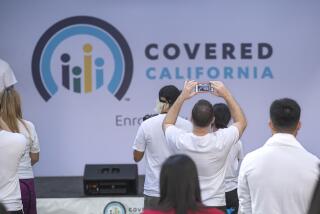Opinion: The trade-offs of Obamacare’s preexisting condition coverage

Polls have consistently shown that even though the public opposes Obamacare, people like some of its most significant provisions. That’s particularly true of the requirement that insurers ignore preexisting conditions when signing up customers for coverage.
Yet that one provision, also known as guaranteed issue, is responsible for trade-offs that people bitterly oppose.
Here are two good illustrations of this dichotomy. In The Times on Monday, Soumya Karlamangla reported on the plight of some of those who aren’t poor enough to qualify for Medi-Cal, the insurance program for Californians with incomes near the poverty line. For this group, it can be a challenge to buy insurance even with the subsidies provided by the 2010 Affordable Care Act. That’s because of the deductibles and co-pays that insurers impose to keep their premiums down.
Some critics argue that the ACA raised the cost of insurance unnecessarily by requiring policies to be comprehensive, including some types of coverage that much of the public might opt not to carry (e.g., maternity or mental health). That’s a factor, although such coverage is common in group plans, which nevertheless have been considerably less expensive than individual ones. The law also makes it hard for people over age 30 to sign up for bare-bones catastrophic plans, which can be more affordable.
A more significant cost factor, though, is guaranteed issue: the ACA’s requirement that insurers offer policies to everyone, regardless of how much treatment they may need. The law also requires insurers to charge applicants with preexisting conditions no more than those with clean bills of health, an approach known as community rating. The net result is more costs for insurers to absorb, and those costs have to be spread broadly across the customer base.
You can also blame guaranteed issue and community rating for the law’s requirement that virtually all adult Americans carry insurance. Otherwise, people would have an incentive to sign up for coverage only when they needed care.
That’s exactly what 63-year-old Barbara Garnaus, the focus of Karlamangla’s piece, did. A part-time worker, Garnaus had no health benefits from her employer, the Orange County school district. She saved money by going uninsured, staying healthy and receiving free checkups at a local clinic. Last year, however, she contracted uterine cancer. At the time, the county offered care to those earning up to twice the poverty line, a limit just high enough to include Garnaus, and it enrolled people as soon as they needed treatment. As of Jan. 1, however, Garnaus’ only options were Medi-Cal -- which she didn’t qualify for, based on her income -- and private insurance. So she signed up for a subsidized plan with monthly premiums of only $13.50, although the co-pays of $20 to $100 per procedure are hard for her to afford.
If Congress hadn’t enacted the ACA, Garnaus would either be getting care entirely on the taxpayer’s dime, as Orange County used to provide, or in a hospital emergency room, where her costs would be passed on to people with private insurance plans. No private insurer would cover her, at least not at rates she could afford. In other words, the public would be largely paying for Garnaus’ care with or without the 2010 law. The main differences now are that she doesn’t have to wait for her problems to become acute before seeking treatment, and that she has to pay a small percentage of the cost. That makes her less likely to seek care frivolously, although it may also deter her from using more expensive diagnostic services that could detect relapses sooner.
The individual mandate isn’t the only way to guard against people trying to game the system. One other mechanism being employed as part of the ACA is the limited time insurers and state insurance exchanges give the public to sign up for a plan. This open enrollment period, a standard feature of employer plans that nevertheless drew outrage from Fox News’ Jim Angle last week, means that uninsured Americans may have to wait until the next open enrollment period begins in November to sign up for a policy, which won’t take effect until January 2015. The exceptions are those who experience a significant change in their lives -- for example, switching to a job without health benefits -- or those who live in Nevada, where state law requires insurers to enroll residents year-round.
Nothing in federal law bars insurers from signing up customers whenever they please. It’s just that they have an incentive not to do so outside the open enrollment period because that would encourage people to sign up only after they needed care. In the past, they could deny coverage for preexisting conditions or impose long waiting periods before coverage became effective; today, they can’t. Instead, they use open enrollment periods to encourage people to get insurance while they’re healthy.
Of course, some critics of the ACA argue that healthy people shouldn’t be forced to obtain coverage, particularly under a cost structure that forces them to pay part of the tab for procedures they’ll never need. But the thing is, healthy people can’t predict what care they eventually will require, if any.
The old system allowed people to minimize their contribution to the system until they needed care, as Garnaus did. The ACA tries to spread the cost more evenly across the population and across individual lifetimes, with younger, healthier people paying more than they did before and older ones in more need of care paying less. Some version of that trade-off is inherent in any system that features guaranteed issue and community rating.
ALSO:
Beyond the Heartbleed threatCongress, extend jobless benefits, again
Follow Jon Healey on Twitter @jcahealey and Google+
More to Read
A cure for the common opinion
Get thought-provoking perspectives with our weekly newsletter.
You may occasionally receive promotional content from the Los Angeles Times.







